After an early start the day before, I opted for a bit more of a leisurely morning for my day in Bergen. The hotel certainly helped with that. I can’t recall the last time I had a breakfast with such a view, thanks to the hotel being built right on the water. After checking out and putting my monster suitcase into storage at the hotel, it was time to explore the city. To be fair though, I only had one real destination today, Mount Fløyen. This 400 meter high mountain towers over the city centre of Bergen. More importantly for me, it is accessed by a funicular, and that funicular was my first stop of the day. Ticketing was done via mobile phone and before long, I was in the cabin and heading up the mountain. Word to the wise, the city station of the funicular is underground and there’s actually a slight incline down from the ticket office.
 |
| Talk about breakfast with a view! |
 |
| It may not look like much, but the day will turn out to be spectacular! |
 |
| You're never too far from an offshore service vessel in the city. Bergen is a major base for Norway's extensive offshore oil and gas sector. |
 |
| I love it when funiculars like the Fløibanen are easily reachable just by walking! |
Once at the top, I was honestly speechless. The views from the viewing platforms near the funicular’s summit station were simply spectacular, helped by the bright, if cold, day and the brilliant sunshine. The entire city was spread out under me, from the port to the city centre to the eastern suburbs. I love a good view, so I stayed up there much longer than I’d originally planned. Okay, I also had some difficulty getting around because the ground was partially iced over and my legs still weren’t back up to speed as much as I’d like. Eventually though, I decided to head back down, in order to thaw myself out as much as for getting ready for boarding. After warming up in a café in Bergen for another hour or so, I walked back to the hotel, grabbed my suitcase, and headed to the shuttle bus stop. Yes, I know that the Jekteviksterminalen, the departure point for coastal ferries in Bergen, is not all that far away my hotel. But between my legs, the fact that the way there wasn’t exactly flat, and the fact that my suitcase was just a few grams away from forming an event horizon. The shuttle bus stop wasn’t too far away and soon, a bus turned up to take me and two other passengers for that day’s departure over to the coastal ferry terminal.
 |
| Talk about a view! |
 |
| Even with the glorious sunshine, it was freezing cold! |
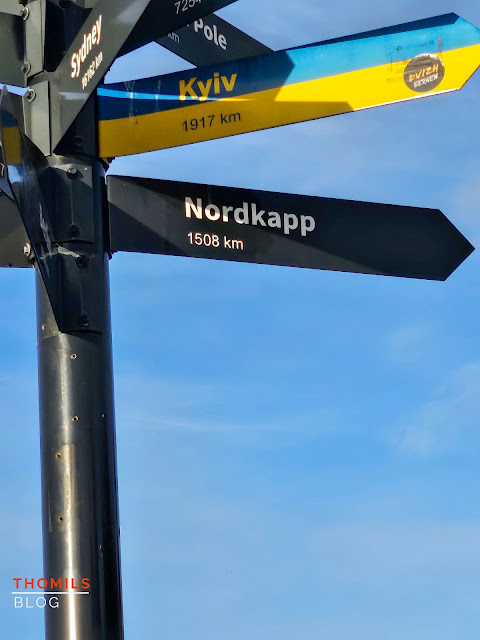 |
| Only 1508 kilometres to go... |
 |
| From now, it's just downhill. Literally... |
 |
| Talk about a Starbucks in a unique building... |
This is where the “fun” began. My itinerary showed a check-in time of 1445h local. However, the ship must have been late on arrival into Bergen as it still hadn’t started by the time I arrived at the terminal some thirty minutes later. In fact, the arriving passengers hadn’t started picking up their bags. It took another thirty minutes for check in to start, although things moved quickly once they got going. Check-In itself was pretty straightforward. Bergen is the only port on the coastal route where this happens in a terminal and includes baggage handling. Accordingly, I dropped off my suitcase which would be delivered to my cabin aboard, got my photo taken, which would be used by the gangway watch to identify me if I left the ship in a port, and picked up my cruise card.
 |
| There she is! Havila Castor tied up alongside at Jekteviksterminalen. |
 |
| Check-In facilities aren't exactly spacious. |
 |
| Luggage carts waiting to be brought aboard Havila Castor. |
 |
| Boarding Havila Castor, you don't know for how long I dreamed of that particular moment! |
Boarding had already started by the time I made it to the gangway. Once again, Bergen is unique in this regard, as this is the only port where boarding happens via a terminal gangway. The ships use their built-in gangways in all other ports. Walking along the glass walkways to the gangway was a surreal moment, one that I still have trouble believing that it was actually real. For years I’d dreamt about taking this journey, read articles, watched an unholy number of YouTube videos, and now I was here. The ship moored outside, Havila Castor, would be my ship, at least for the next twelve days! Even now as I’m firmly back in the daily grind here in Ireland, I get excited again just thinking back at this moment. It wasn’t all fun and games though, and by the time I got onboard, I needed to find a place to sit down, so my conversation with the crew member on gangway watch was pretty short. After I’d recovered a bit, it was time to queue some more. My cabin wouldn’t be ready until 1900h and I had nothing better to do, so why not? In all seriousness, there was still some stuff that needed to be taken care of. I needed to book my table for lunch and dinner, which would be fixed for the entire journey, and I also had to get my drinks packages sorted. Coffee, tea and water were included in my meal package, as were all my main meals aboard, but any other drinks would have to be paid separately. Knowing that the drinks prices in Norway would make Dublin’s Temple Bar look like a low-cost destination by comparison, I decided to spring for both an alcoholic and non-alcoholic drinks package, although I got the smallest one for each, since I wasn’t planning to drink myself to oblivion.
 |
| The bow lounge on Deck 6 turned out to be one of my favourite places on the ship! |
 |
| The central atrium, which also houses the ship's lifts, connects all publicly accessible decks of the ship. |
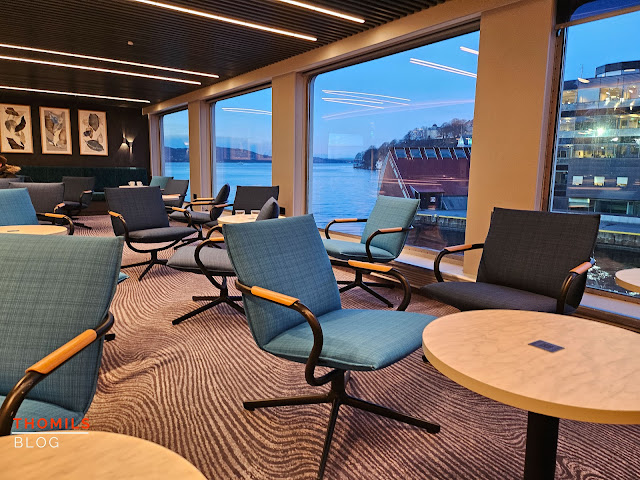 |
| This seating area is one of the first areas you see when you board the ship in Bergen. |
With these formalities taken care of, I decided to explore the ship. I mostly just wandered around the inside deck areas, taking in the décor and just trying to come to terms with the fact that, despite all my problems, despite the job loss, the burnout and the health issues, I had made it here. There’s a dedicated article on Havila Castor but in brief, the ship has five main passenger decks. Deck 4 is the lowest deck regularly open to passengers and contains mostly passenger cabins. It also houses the reception desk and the ship’s retractable gangway that is used for boarding outside of Bergen, as well as the ship’s sickbay and a passenger laundry. Deck 5 is much the same. It contains the boarding door used in Bergen, a seating area surrounding the ship’s central atrium and elevator core, and more passenger cabins. Deck 6 is the main social hub of the ship. Here you’ll find the ship’s two main restaurants, Havrand and Hildring, the Havly Café, the desk of the onboard expedition team, a large wrap-around passenger lounge, the onboard shop and the conference room that is used by the expedition team for daily meetings and presentations. Deck 7 houses higher-class panorama cabins and suites, the ship’s two gyms as well as an outside deck area. Deck 8 only contains two passenger cabins, the two premier “Lighthouse Suites” and is mostly an outdoor deck that comprises the Havbris bar, the ship’s two saunas as well as the twin hot tubs. Finally, Deck 9 contains a walkaround panorama deck as well as the Havblikk panorama lounge.
 |
| My cabin, 4309. I'm not gonna lie, I've had hotel rooms that were much smaller! |

Shortly before 1900h, an announcement was made that the cabins on Deck 4 were now ready for passengers. My own cabin was 4309 on the ship’s port, or left, side and relatively far aft and I have to say that I was impressed. It was just a standard outboard cabin, but it was pretty large for such a regular cabin. In fact, it was larger than the hotel room I’d spent the previous night in. The décor was understated and classy and, as you’d expect from a ship that’s barely two years old, in great shape. I’ve always been a fan of this style and Havila has implemented it perfectly as far as I’m concerned. Hell, this cabin was in better nick than some “premium” hotel chains I’d stayed in on past travels. Yes, I’m looking at you, Hilton Midtown Manhattan! That said, I did feel a bit uneasy about the elevated bathroom and its “hatch”, but I guess that’s unavoidable, given that you’d need to put all the pumps and plumbing somewhere. By time I’d put away all my clothes and stowed away my suitcase, it was almost time for dinner, so I made my up to Havrand, the ship’s main restaurant.
 |
| Beef carpaccio with crispy capers. Absolutely lovely! |
 |
| Strawberry & rose sorbet! |
There’s only a limited buffet service on Havila ships, and both lunch and dinner are sit-down a-la-carte affairs, hence the fixed meal times and table assignments. On this first night aboard, things weren’t quite as regulate though and I was just seated at the next available table. In what would become a theme for this journey, the food was excellent. Dinner was served in a standard three-course format and the menu would change every couple of days to reflect the parts of the country we were passing. On this first day I opted for a beef carpaccio as a starter, followed by poached Lofoten salmon with sauce hollandaise and crispy capers and a strawberry and rose sorbet as a dessert. As mentioned before, it was excellent, and by the time I’d finished my meal, we were underway. The journey I had been dreaming of, striving for, for such a long time had begun!
 |
| There's something magic about watching us leave Bergen from the Deck 9 observation lounge. |
 |
| But enough of the lyrical extravagance, let's get back to the pint! |
 |
| A drilling rig outside Bergen, accompanied by a number of offshore service & supply vessels. |
With the inherent stress of the first few hours onboard falling away, I went up to the Deck 9 observation lounge for a cold one and just watched the lights of Bergen and the surrounding towns pass by. As Havila Castor pressed on further and further into the night, I began to notice a slight rocking sensation. The Atlantic was making its presence known with the first gentle waves, which seemed like the perfect way to bookend this incredible first day. After snapping a few pictures of a passing oil rig surrounded by a fleet of support vessels, I decided to run in and let the waves gently rock me to sleep.
Day 2 – November 20th 2024
So much for being gently rocked to sleep! We had called at the ports of Florø and Måløy overnight and shortly after leaving the latter, Havila Castor had been forced out into the open Atlantic by the Stadlandet peninsula. This area of the Norwegian coast is notorious for its rough conditions even on good days and it had lived up to its reputation overnight. I hadn’t gotten seasick but sleep was equally impossible. By 0700h, I’d had enough and decided to get up, forced out of bed by both the seas and the temperature in my cabin. I hadn’t quite mastered the air conditioning controls yet. By the time I’d made myself presentable, we were approaching the port of Fosnavåg, the home of Havila Voyages and the larger Havila group as a whole. However, I was really interested in the port of Torvik, which we reached soon afterwards.
 |
| The morning after - passing Havila's headquarters at Fosnavåg. |
 |
| Torvik is typical of many of the smaller routes on the coastal route. |
 |
| I'm afraid we roughed up that fishing boat next to the Torvik pier quite a bit with the wake from our drive pods. |
As far as I’m concerned, Torvik is one of the quintessential coastal route ports. Nestled into a small cove and framed by low wooded hills, it is literally just a pier and warehouse surrounded by fields, small homes and farmhouses. It is about as far away from a major cruise port as you can get. And on this November morning, it was simply a magical sight. Everything was covered with a crisp, pristine blanket of freshly fallen snow that turned an already pretty landscape into a winter wonderland. Despite this post card landscape though, Torvik also showed just how much the coastal route is part of everyday life in Norway. There was no fanfare. Waiting for Havila Castor on the quay were twelve pallets of cargo, as well as a number of cars with their engines running. The latter were waiting to either collect or drop off passengers on the ship, a sight both remarkable for the beauty of its surroundings and utterly mundane in its nature. How many times had my parents waited for me like this in Speyer, Mannheim, Frankfurt, Heidelberg?
 |
| Sunrise over Breidsundet... I think... |
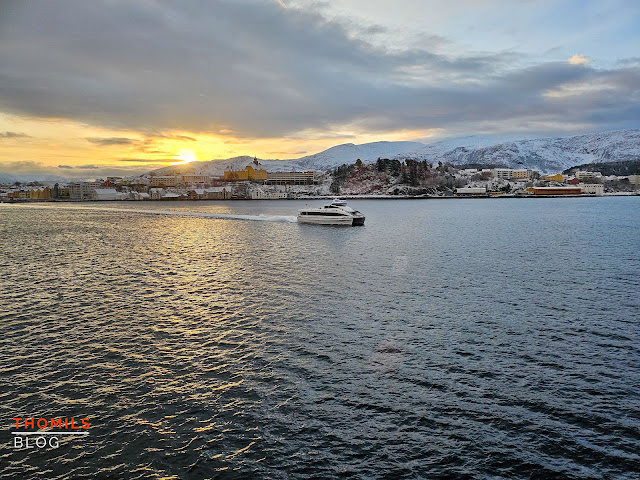 |
| Passing a local ferry as we approach Ålesund. |
 |
| My view from alongside the pier in Ålesund - So long as the weather allowed! |
We were scarcely alongside for more than five minutes before the gangway and cargo ramp were raised and the lines cast off, another indication of just how mundane these ships are around here. The biggest port call of the day was ahead of us though, Ålesund. We would stay there for a total of eight hours, a special feature of the winter timetable. In spring and summer, ships on the coastal route enter the massive Geirangerfjord, which is a highlight of the trip for many travelers on the route. However, the fjord is closed to large ships in winter, which leads to the long stay in Ålesund. The city itself is renowned for its art nouveau architecture, an after effect of a massive fire that had swept through, and destroyed, much of the wooden old town in 1904. The distinctive style of the rebuilt city is primarily due to the donations of one particular benefactor that spent a considerable amount of his fortune on rebuilding the city: Germany’s emperor Wilhelm II, who was enraptured with Norway and would often spend the summer cruising the fjords aboard the imperial yacht Hohenzollern. I guess Germany’s love affair with Scandinavia goes back farther than I thought.
 |
| View? What view? |
Given our extended stay in Ålesund, I’d originally planned to head out and explore the city on my own. Unfortunately, the last two days had left my legs feeling pretty wobbly and I was honestly just exhausted, so I decided to simply stay aboard whilst most other passengers headed out either on guided excursions or to explore the city on their own. The frequent snow and Graupel showers made the decision even easier. At least onboard, I was never too far away from a handrail. And so, I spent much of the day relaxing, watching the world go by outside the ship and observing the crew run tests on the lifeboats and their davits. There was also a steady stream of locals that came onboard to have breakfast, lunch, or just grab a coffee in the Havly café, something that’s a regular occurrence with these ships. It also gave me the chance to try out the onboard lunch for the first time, which was once again served in the Havrand restaurant. This is another peculiarity of Havila ships. In order to reduce the amount of food waste produced as much as possible, lunch consists of a changing menu of small dishes, and it is generally recommended not to order more than 3-4 and a small dessert. Now I’m the first one to admit that I generally have the appetite of a stellar-mass black hole , but even I found the 3 small dishes to be more than sufficient. The broccolini with hollandaise turned out to be less broccoli and more like a small tree though.
 |
| Lunch, Havila style! More than enough even for someone like me. |
 |
| It's rare to see the bow lounge this empty. The places by the fireplace are usually among the first to be taken... |
 |
| My iPad ended up doing a lot of heavy lifting as an image tank on this trip! |
 |
| I made sure to get some fireplace time while I could ;) |
Much of the afternoon was spent in the same way, with me alternating between reading near the ship’s two fake fireplaces in the bow lounge, sorting through the hundreds of pictures I’d already taken on this journey, and trying to take in as much of the surrounding scenery as possible before the sun set. I was already farther north than I’d ever been in my life and the early sunsets were already beginning to have an effect on me. The calm aboard the ship certainly helped though, the atmosphere on the ship was just chill. There was no loud music, very little loud talking and the lighting was subdued and cozy. Often, the loudest noise would be the sound of the coffee machines in the forward lounge, given that they were free for cruise passengers.
 |
| Dinner on the first full day. Halibut tart as a starter! |
 |
| Lamb shank on a wild mushroom sauce was the main. It was a bit tough but delicious! |
 |
| The sea buckthorn panna cotta I had for dessert was just divine though! |
As the sun set, the ship slowly began to fill with life again as cruise passengers started trickling back in from their excursions and solo sojourns. We departed Ålesund bang on time, just after taking on the last of the returning cruise passengers. The ships on the coastal route will not hang around and wait for any tardy passengers, they have a schedule to keep. We would have one more port on our list for this day though, the town of Molde, a name that Autocorrect on my iPad tried to convert to my family name, Milde, on more than one occasion. We’re not quite notorious enough to have towns named after us yet, I’m still working on that. Give me some time, will ya?
 |
| Approaching the port of Molde. |
 |
| Alongside at the port. Those pallets next to the forklift ended up being loaded onto our ship. Apologies for the reflections, this shot was taken through my cabin window. |
Day 3 – November 21st 2024
By the time I woke up the next morning, feeling surprisingly good, we were already approaching our next big port of the journey, the city of Trondheim. The Hustadvika, an exposed stretch of water between Molde and the port of Kristiansund, where we had called overnight, is just as notorious for its rough conditions as the Stadhavet we’d passed the previous night, had apparently been on its best behaviour. Either that, or I was just completely wrecked, both were distinct possibilities.
After a quick but delicious breakfast, (somebody get me Havila’s recipe for scrambled eggs, seriously!) I spent much of the morning watching our passage through the seemingly endless confines of Trondheimfjord towards Norway’s oldest city. I’ll be honest with you here, after the beautiful landscape surrounding Torvik and Ålesund yesterday, the Trondheimfjord was a bit of a letdown. Due to differences in geology and glaciation during the ice ages, the land around Trondheim is far less rugged and consists mostly of low, gently rolling hills. The approach into the city was nevertheless breathtaking, because it was bloody cold. Any Scandinavian (or Canadian for that matter) reading this will probably have a good laugh at this, given that it was only around -7°C outside, but it was still cold enough to watch steam rising from the waters of the fjord as we got closer to the city. It was a brilliant day otherwise, with hazy sunshine and only the occasional cloud.
 |
| Dawn over Trondheimfjord... |
 |
| Like all ships on the coastal route, Havila Castor still proudly flies the ensign of a Norwegian mail ship. |
The approaches to the port, and city, of Trondheim are guarded by Munkholmen, the “monk’s island”. This island has, at various times, served as a place of execution, a monastery, a fortress, a prison, and a gun battery, as was pointed out by the expedition team during our first event out on the aft end of Deck 8. Shortly before reaching Munkholmen, Havila Castor had already passed the southbound Hurtigruten ship Richard With, named after the man who’d laid the foundation for the coastal route over a century earlier. I’ll be honest, watching a ship in the classic white, red and black colours of Hurtigruten pass us by was an emotional experience for me. Ships in these colours had been the focus of the many TV documentaries about the coastal route that I had watched with my parents, and seeing one of these ships in real life, without my parents standing next to me, hit me harder than I’d expected.
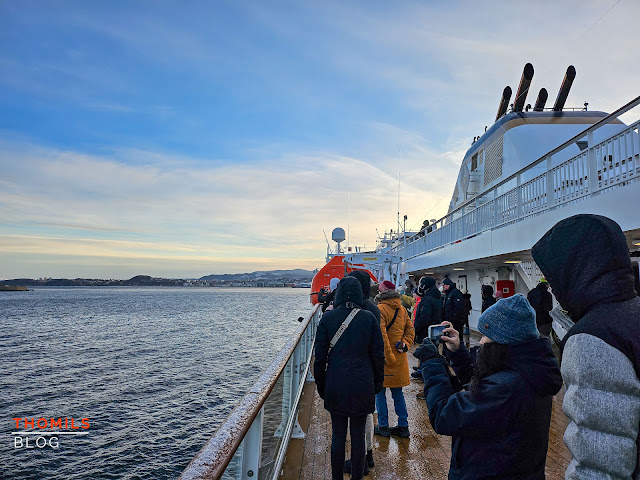 |
| Outside on Deck 8 as we approach Trondheim. Yep, it's cold! |
 |
| The sun may be beautiful, but it can't really dispel the cold outside. |
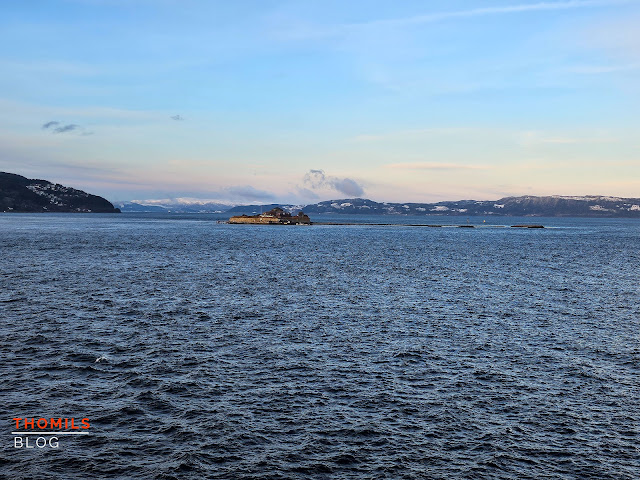 |
| Munkholmen island, the "guardian" of Trondheim. Also a monastery, fortress, prison, and a place of execution. Talk about a warm welcome ;) |
 |
| The dreaded competition ;) Hurtigruten's Richard With just outside of Trondheim, starting the last leg of its southbound journey from Kirkenes. |
Our stay in Trondheim was another long one, though this one was only four hours long. However, my legs still weren’t really up to the task and we were tied up in a remote, industrial part of the port, so I once again opted to stay onboard for the entirety of our stay. The freezing temperatures certainly helped my decision along as well though. The calm aboard was what I needed most if I’m honest with you.
 |
| Our berth lies in the industrial part of the port of Trondheim. |
 |
| That means it's admin time for me. Thank goodness the coffee onboard is free! |
 |
| Leaving Trondheim. Yes, the sea is actually steaming because it's so cold! |

We departed Trondheim on time, shortly after lunchtime, sailing out into the still steaming waters of the fjord. The mist rising up from the waters, bathed in the warm rays of the setting sun, was a sight to behold, one that I hadn’t expected to see. It was stunning though, all the more so given that I was able to watch it from the warmth of the ship’s lounges. The cold didn’t stop some mad lad from running around the exterior walkway around the Deck 9 observation lounge in just sweatpants, trainers, and a hoodie. On the highest point of the ship. Whilst sailing into a stiffening and freezing breeze. And I thought I was comfortable in cold weather! I opted for a more warming course of action, making use of my drinks package to grab an Irish Coffee from the bar in the lounge. And what do you know, they make a damn good one on the ship. Not quite as good as back in Cork at the Shelbourne, but not far off. By the time we reached Skjærungskjær Fyr, the lighthouse at the end of Trondheimfjord, dusk was well and truly upon us even though it was just after three in the afternoon. The darkness of the polar night was beginning to make itself felt. Darker days Stil were ahead.

 |
| The sun sets before we even have a chance to leave Trondheimfjord. |
 |
| Kjerungskjær fyr marks the end of Trondheimfjord. |
 |
| Fun fact. Irish Coffee tastes much better when had in the observation lounge of a ship heading into the Arctic ;) |
The rest of the day passed equally quietly. The stretch of coast between Trondheim and Rørvik is the largest section of coast without a stop on the coastal route. The area had been served in the past, but infrastructure improvements had reduced the travel time in this area to a point where coastal ferries simply weren’t needed anymore. As such, Havila Castor worked its way north through the darkness, pitching and rolling gently as we dipped into and out of the open waters of the Atlantic and the protected inside passages of the coast. The hushed calm aboard had spread to the passengers, with only quiet conversation, occasional bursts of muffled laughter, and the equally occasional whirring of coffee machines interrupting the calm. We were still nearly two hours away from Rørvik when dinner was served. Given the occasional bits of wave action, I opted for something not prone to spillage, starting with a favourite of mine, the beef carpaccio, before moving on to what the menu called a ”sailor’s steak”. I can guarantee that no sailors were harmed in the production of this steak, it was simply a regular steak served with red wine jus. An absolutely heavenly Hardanger Apple Cake rounded out the meal, and yes, I’m aware that this is beginning to sound like a food blog. Deal with it!
 |
| Dinner started with another beef carpaccio. |
 |
| Sailor's steak in red wine jus. No sailors were harmed in the production of this steak ;) |
 |
| Hardanger apple cake with lemon cream. This stuff is highly addictive! |
By the time dinner was over, we were on the approach to Rørvik, where we arrived just before 2200h. Once again, I was outside on Deck 8 to watch our arrival. Even at this late hour, there was at least one car waiting for us on the quayside, and a solitary passenger stood way back against a building with their trolly, waiting for Havila Castor to be safely tied up before coming aboard, a further reminder, if any more were needed, of the utilitarian nature of this journey. With the temperatures falling, I made my way down to my cabin. The next day would turn out to be one of the most spectacular ones on this journey.
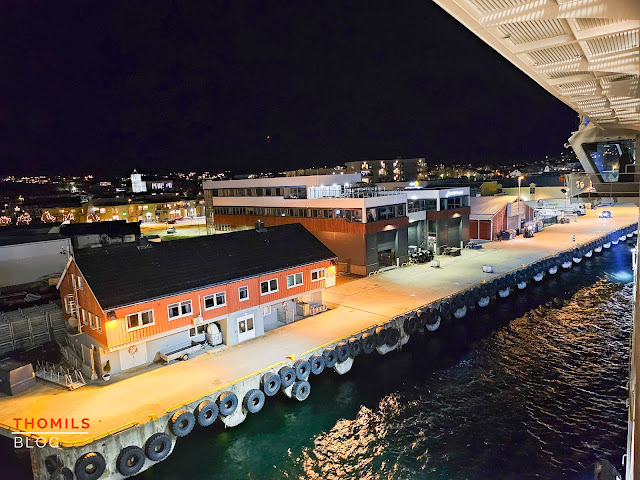 |
| Approaching the quay at Rørvik just before 10 PM. |
 |
| This distinctive building is the Norwegian coastal museum in Rørvik. |
 |
| Some locals waiting to board Havila Castor in Rørvik. The ship really is more like a long distance coach or an overnight train. |
Click here to get to Part 3


























































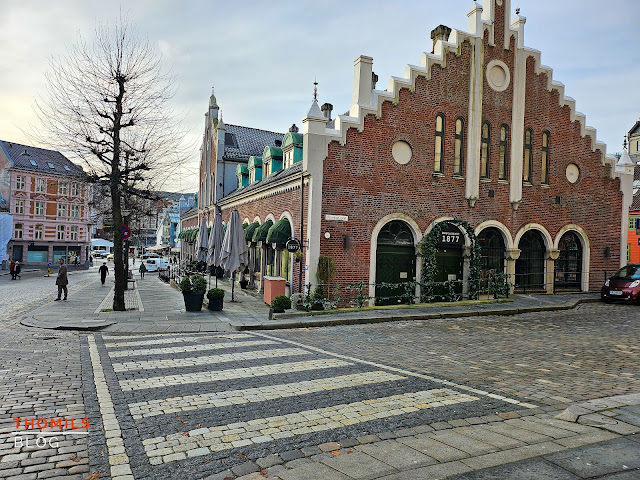



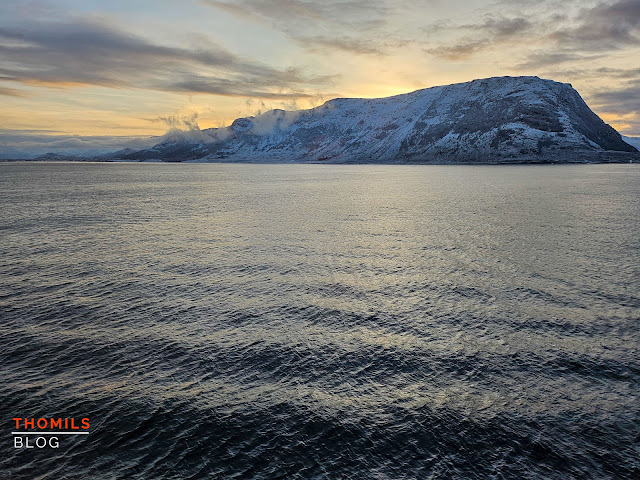




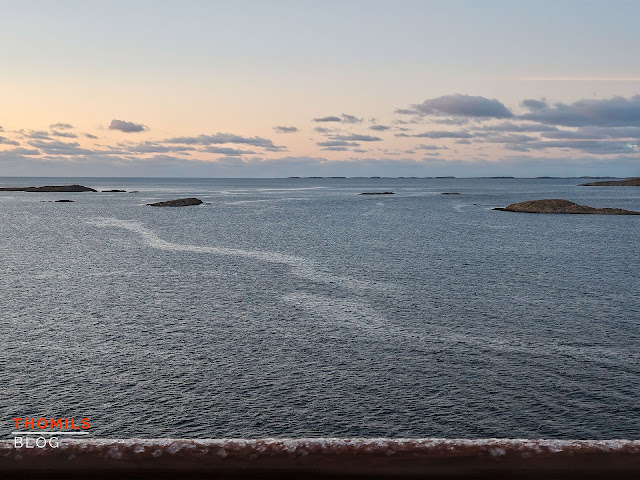



Comments
Post a Comment